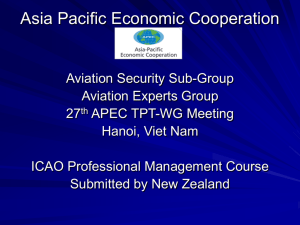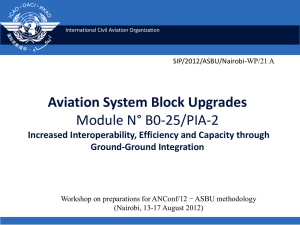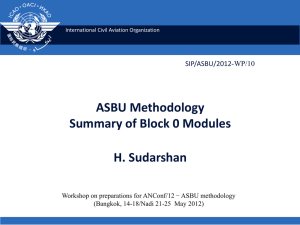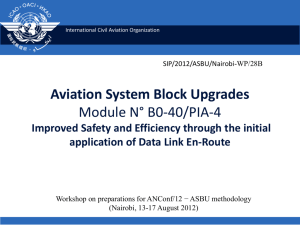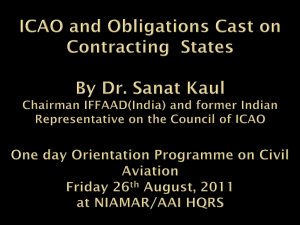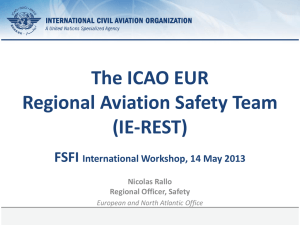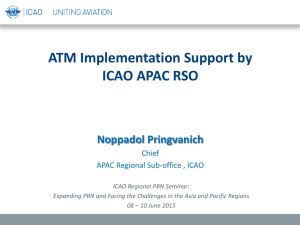Improved Flexibility and Efficiency in Descent Profiles (CDOs)
advertisement
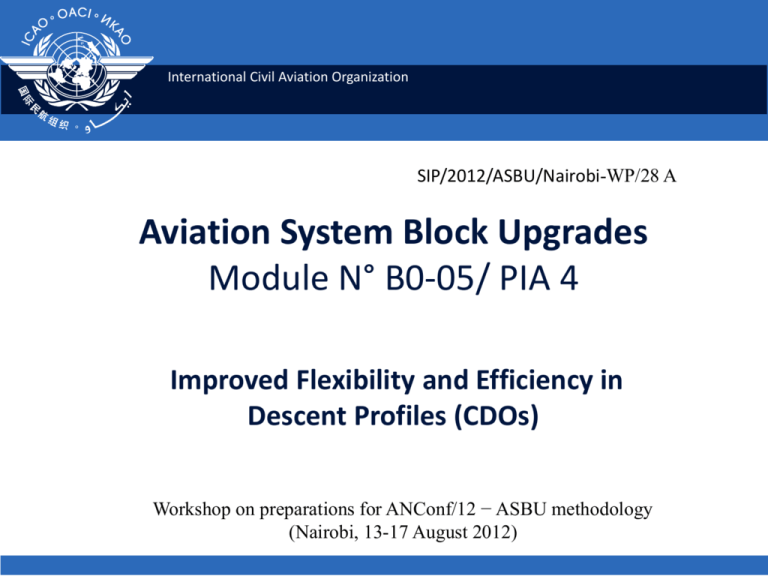
International Civil Aviation Organization SIP/2012/ASBU/Nairobi-WP/28 A Aviation System Block Upgrades Module N° B0-05/ PIA 4 Improved Flexibility and Efficiency in Descent Profiles (CDOs) Workshop on preparations for ANConf/12 − ASBU methodology (Nairobi, 13-17 August 2012) Module N° B0-05 Improved Flexibility and Efficiency in Descent Profiles (CDOs) Summary Deployment of performance-based airspace and arrival procedures that allow aircrafts to fly their optimum profile taking account airspace and traffic complexity with continuous descent operations (CDOs). Main Performance Impact KPA-03 – Cost-effectiveness; KPA-04 – Efficiency; KPA-09 Predictability Operating Environment/Phases Approach/Arrivals and En-Route. of Flight Global Concept Component(s) AOM – Airspace Organisation and Management Global Plan Initiatives (GPI) AO – Aerodrome Operations TS – Traffic Synchronisation, AOM GPI-10- Terminal Area Design and Management; Pre-Requisites Global Readiness Checklist GPI-11- RNP and RNAV Standard instrument Departures (SIDS)and Standard Terminal Arrivals (STARS); NIL Status Standards Readiness Ready Avionics Availability Ready Ground System Availability Ready Procedures Available Ready Operations Approvals Ready ICAO SIP 2012-ASBU Workshop. Block Upgrades N° B0-05 2 Module N° B0-05 - Baseline • Varies from one State/region to the next. • Some aspects of the movement to PBN have already been subject of local improvements in areas ICAO SIP 2012-ASBU Workshop.Block Upgrades N° B0-05 3 Module N° B0-05 – Change brought by the Module • Continuous Descent Operations (CDO) – CDO is enabled by airspace design, procedure design and facilitation by ATC – An optimum CDO starts from the top-of-descent (TOD) and uses descent profiles that reduce controller-pilot communications and segments of level flight. • Performance -based Navigation (PBN) – The PBN concept encompasses two types of navigation specifications RNAV/RNP – PBN STARs ICAO SIP 2012-ASBU Workshop.Block Upgrades N° B0-05 4 Module N° B0-05 – Intended Performance Operational Improvement Efficiency reduced fuel burn authorization of operations where noise limitations would otherwise result in operations being curtailed or restricted reduction in the number of required radio transmissions optimal management of the top-of-descent in the en-route airspace Environment Reduction on CO2 through reduced fuel burn Predictability More consistent flight paths and stabilized approach paths Less need for vectors Safety CBA If implemented within the ICAO CDO manual framework, it is envisaged that the benefit/cost ratio (BCR) will be positive. more consistent flight paths and stabilized approach paths reduction in the incidence of controlled flight into terrain (CFIT) Separation with the surrounding traffic reduction in the number of conflicts. ICAO SIP 2012-ASBU Workshop.Block Upgrades N° B0-05 5 Module N° B0-05 – Necessary Procedures (Air & Ground) • ICAO Continuous Descent Operations (CDO) Manual (Document 9931) – Provides guidance on the airspace design, instrument flight procedures, ATC facilitation and flight techniques necessary to enable continuous descent profiles. • ICAO Performance-based Navigation Manual (ICAO Document 9613) – Provides general guidance on PBN implementation. ICAO SIP 2012-ASBU Workshop.Block Upgrades N° B0-05 6 Module N° B0-05 – Necessary System Capability • Avionics – CDO does not require specific air/ground technology. • Ground Systems – PBN requirements will be affected by CNS/ATM environment ICAO SIP 2012-ASBU Workshop.Block Upgrades N° B0-05 7 Module N° B0-05 – Training and Qualification Requirements • Training in the operational standards and procedures are required for this module • Likewise, the qualifications requirements are identified in the regulatory requirements ICAO SIP 2012-ASBU Workshop.Block Upgrades N° B0-05 8 Module N° B0-05 – Regulatory/standardization needs and Approval Plan (Air and Ground) • Regulatory/Standardization: Use current published requirements • Approval Plans: Must be in accordance with application requirements e.g. airspace design, air traffic operations, PBN requirements for fixed radius transitions, radius-to-fix legs, Required Time of Arrival (RTA), parallel offset, etc ICAO SIP 2012-ASBU Workshop.Block Upgrades N° B0-05 9 Module N° B0-05 – Reference Documents • Standards – For flight plan requirements in Amendment 1, ICAO Document 4444; PANS/ATM v15 • Procedures • Guidance Material – ICAO Doc 9613, Performance-based Navigation (PBN) Manual; ICAO Doc 9931, Continuous Descent Operations (CDO) Manual;. – FAA Advisory Circular, AC 90-105, Approval Guidance for RNP Operations and Barometric Vertical Navigation in the U.S. National Airspace System) which provides system and operational approval guidance for operators (only reflects the US situation). • Approval Documents – ICAO Doc 9931, Continuous Descent Operations Manual; – ICAO Doc 9613, Performance Based Navigation Manual; – FAA AC120-108, CDFA. ICAO SIP 2012-ASBU Workshop.Block Upgrades N° B0-05 10 Module N° B0-05 Implementation - Benefits and Elements Improved Flexibility and Efficiency in Descent Profiles (CDOs) Benefits - Main Key Performance Areas (KPA) KPAs Applicable Access Capacity Efficiency Environment Safety N N Y Y Y Elements: CDO and PBN STARs No avionics or Ground systems are required To be reflected in ANRF ICAO SIP 2012-ASBU Workshop. Block Upgrades N° B0-05 11 ICAO SIP 2012-ASBU Workshop. Block Upgrades N° B0-05 12


